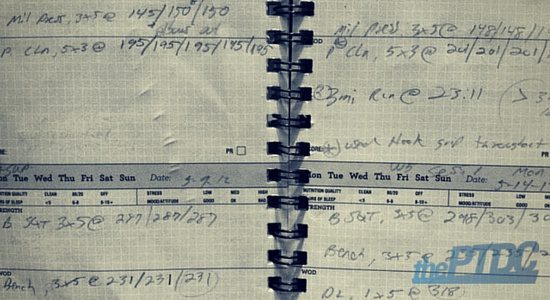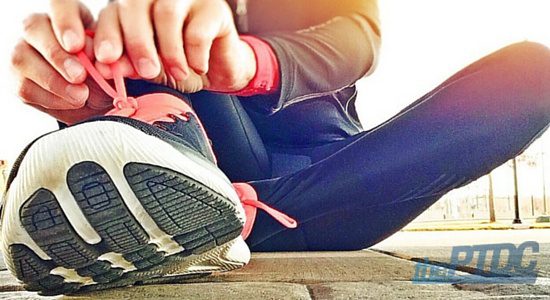This blog post originally appeared on Robertson Training Systems. It has been reposted here on The PTDC with permission.
If you've been training for any period of time, chances are you've kept a training log at some point in your career.
A training log is an invaluable tool because it goes a step further than the typical tracking of sets, reps, etc. A training log digs deeper into each training session:
- What was your energy level like in the gym?
- How did the weights feel? Heavy? Light?
- What was your technique like?
- And what things do you need to remember or work on next time with regards to technique?

These are just a few examples of things you can record because a training log is something that will help you track the little things that get you results.
But here's something that I think is every bit as valuable, if you're a coach...
Enter the Coaching Log
A coaching log is like a training log--only you write in it after you finish your training sessions with your athletes.
You include the following:
- How did John's training session go today?
- What is Susan doing well in her lifting technique?
- How did you finally break the ice when chatting with Lamar?
Basically, a coaching log is a simple way for you to debrief after every training session. It helps you not only better understand your athletes, but yourself as well.
I didn't always have a coaching log myself...
I'm a little ashamed to say this, but I didn't start keeping a coaching log until 2013, when I trained Roy Hibbert.
If we're being transparent, I was nervous as f*** when I started training Roy. The obvious elephant in the room is that he makes a ton of money, and the last thing I wanted to do was screw him up.
He was the highest profile pro athlete I'd ever trained, and essentially the poster boy for our training here at IFAST. Training him was a huge deal.
Quite simply, there was no way I could let him fail.
Training Roy was a challenge, though, mostly due to his height. Everyday exercises like lunges, squats, and even trap bar deadlifts were more difficult for him to manage than most.
So after putting together his first training block, I made it a habit to take 2-3 minutes after every session and write down what we did with him that day.
I didn't want to leave anything to chance.
So the next question becomes, what do you put in your coaching log? Here are some thoughts that might help you out!
Developing your coaching log
Your coaching log, much like a training log, is a unique and individual tool.

In my coaching log, for instance, I'll often jot down a few things:
- The weights I used
- How the weights felt that day, based on an RPE scale
- Whether I should go up, down, or stay the same the following week
- A rating of my technique
- What technical things I need to work on, and cues or thoughts to help me improve upon them
There are other stuff I could track, but those are what work for me.
And that's an important goal here - you have to figure out what works for you.
With regards to the coaching log, here are some things you might want to start tracking.
Sets and Reps
With all our athletes, we're trying to "crack the code" to see what makes them tick.
More specifically, we're always trying to give them a more optimal program.
While I'll typically track and log all of the sets and reps on their training program, if I feel I need to change something going forward, I will note this in my coaching log.
Coaching cues
This is one of the most critical aspects of the coaching log: tracking the coaching cues that each athlete responds best to.
For example, if you're coaching acceleration, these cues might work:
- Big/aggressive arms
- Push the earth away
- Break the glass with your knees
But inevitably, not every cue works the same with every athlete!
Just like we want to figure out what set/rep scheme works best for each individual athlete, we also want to find out what cues work best for a client as well!
The really cool thing here is you get to see how your cues will evolve over time. In the beginning, it may be broad and include general cues like make the arrow on push-ups or feel the whole foot.

But as you work longer and more with athletes, and the better they move, the more specific and individualized your cues become.
Keeping track of this over time will be an invaluable tool for yourself, as well as for your athletes.
General training thoughts
In this section, I like to highlight general thoughts about how the athlete is responding to the training.
- Am I loading them too much? Or perhaps, not enough?
- Am I progressing them too slowly? Or perhaps, not fast enough?
- Is the training fun/engaging?
- Are they improving?
Again, this is just a general area to brain dump. This could also give you some time and space to flesh out what you think this athlete needs going forward, so that you can write better subsequent programs on the back end.
Personal notes and thoughts
Last but not least, this is where I like to jot down thoughts on the human being standing in front of me.
I've mentioned this many times, but we are in the people business.
And if you're not making a connection with the person standing in front of you, you're going to struggle to achieve the level of success you desire.
This area is simple. Note anything that the athlete brings up which could work as a talking or connection point:
- Their favorite artists (or what they're listening to these days)
- What they enjoy doing in their free time
- Major life events (i.e. having a child, death in the family, etc.)
As much as I enjoy training athletes, I also realize that I can't do my job if I don't effectively connect and communicate with them.
Make sure to throw this section in your coaching log - I guarantee it will pay off down the line!
How to get started with a coaching log
After reading this, some people may be thinking:
"Damn Mike, that's a lot of work! There's no way I can do that..."
...which, of course, is absolutely not the case. In fact, I'm going to make this so simple that you can start doing it today (or in the next two days if you have Amazon Prime)! Here's what you need to do:
- Commit to the habit of keeping a coaching log. Tell yourself how valuable it will be to both your and your athletes. And don't be afraid to print this article off and re-read it a few times along the way if you need motivation.
- Pick up a coaching log. I really like moleskin style notebooks, as they just feel nice when you write in them. (And yes, I'm prepared to be ridiculed for giving an emotive answer to this, but I think writing in a nice journal is a critical way to cement your thoughts.) At the very least, write it down on your standard yellow legal pad. It's better than nothing!
- Place the coaching log on your desk. At the end of every training day (or ideally, after every training session), take 5-10 minutes to debrief on all the athletes you trained.

Either use the ideas I outlined above (sets and reps, coaching cues, general thoughts, etc.) or come up with your own.
What's most important here is that you start jotting down and tracking the things that will help you better coach your athletes.
Now here's another really important thing you have to do: The coaching log has to be visible and present for you to actually use it.
- Put it smack dab in the middle of your desk.
- Throw your keys on top of it as a reminder.
- Or put it on your car seat so you can do it before you leave.
If you've read the book The Power of Habit: Why We Do What We Do in Life and Business by Charles Duhigg, you know that he's big on cueing and reminding yourself when building a new habit.
That cue will drive your routine/habit (i.e. writing in your journal), which should lead to the rewards of better training sessions and programs for your athletes.
A coaching log is a simple yet highly effective tool that can make any coach better.
Whether you're just getting started in the industry or you've been coaching athletes for 30 years, this seemingly little tool can take your coaching to the next level.
Commit to keeping a coaching log today, and I guarantee your athletes will reap the rewards for many years to come!
Other trainers found these articles helpful:
- Quick Tips to Design Better Athletic Training Programs by Justin Kompf
- Top 6 Personal Trainer Apps and Tools by Leslie Ann Quillen
- Tracking Training Personal Clients by Jonathan Goodman
Photo Credit: Image #1 (training log) by Flickr, Image #3 (running) by Pixabay










